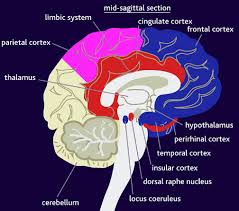The Parietal Cortex
The Role of the Parietal Cortex in Retrieval
Similar to prefrontal cortex Opens in new window, damage to parietal regions does not lead to severe memory deficits, yet this region nonetheless contributes to memory retrieval through its role in attentional and integrative aspects of memory.

Currently, the exact role that parietal cortex plays in retrieval remains unclear, but a variety of models have been proposed (Wagner et al., 2005). Some suggest that parietal regions play a role in helping to direct and maintain attention to internally generated information in memory that is most important for retrieval.
Others argue that parietal regions help to assess familiarity of information which in turn predicts attentional capture for retrieval. Still others posit that parietal regions according to the strength of the memory.
These models are all consistent with a more general role the parietal cortex plays in attention and with its role in integrating information from various modalities. During memory retrieval such operations are performed on internal representations, that is, those related to memory, rather than on stimuli from the external world. Like prefrontal cortex Opens in new window, the parietal cortex is performing operations on memory retrieval that it can also apply in other domains.
We’ll spend the remainder of the literature, discussing some of the evidence regarding parietal contributions to memory retrieval. First, patients with parietal lesions show subtle deficits in memory retrieval (Berryhill, 2012).
For example, when asked to recall information about various autobiographical memories, patients with bilateral parietal damage report information in less detail and less vividly than controls. However, when asked specific questions about their lives, they can answer without difficulty, indicating that the information was successfully retained (Berryhill et al., 2007).
Relatedly, patients with parietal damage have less confidence in their memory recall (Simons et al., 2010) and are less likely to use retrieval cues (Ciaramelli et al., 2010). Such findings suggest that parietal damage may affect the ability to integrate different components of a memory, direct attention to specific details to be retrieved, or to assess familiarity.
Neuroimaging and electrophysiological studies also suggest a role for the parietal cortex in retrieval. Neuroimaging studies report left parietal activation in memory retrieval tasks, regardless of the nature of the content (e.g., verbal, nonverbal) or the modality (e.g., auditory, visual) of the memory.
More specifically when recognition memory is required, left parietal cortex exhibits more activation for studied items correctly identified as “old” — that is, correctly remembered — than novel items correctly identified as “new,” regardless of the nature of the materials (Henson et al., 1999). Similar patterns are observed with ERPs. The old/new parietal positivity effect is greater for previously seen than unseen items, and it too is observed regardless of whether or not an explicit memory decision is required.
Finally, recent research using multi-voxel pattern analysis provided evidence that the type of information being recalled (e.g., face versus scene) is represented by parietal regions in addition to evidence that parietal activity signals that memories have been successfully recalled (Kuhl & Chun, 2014). In sum, while the exact process that the parietal lobe contributes to memory retrieval remains somewhat unclear, this region is nonetheless making a contribution.
See also:
- Marie T. Banich, Rebecca J. Compton, Cognitive Neuroscience (p. 285) Role of the Parietal Cortex in Retrieval

